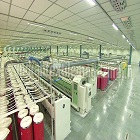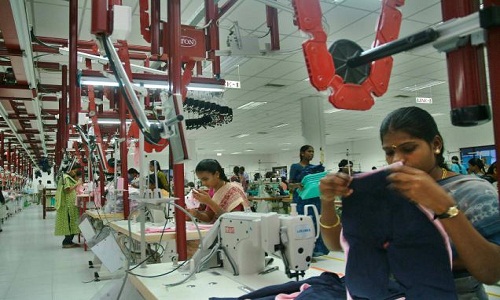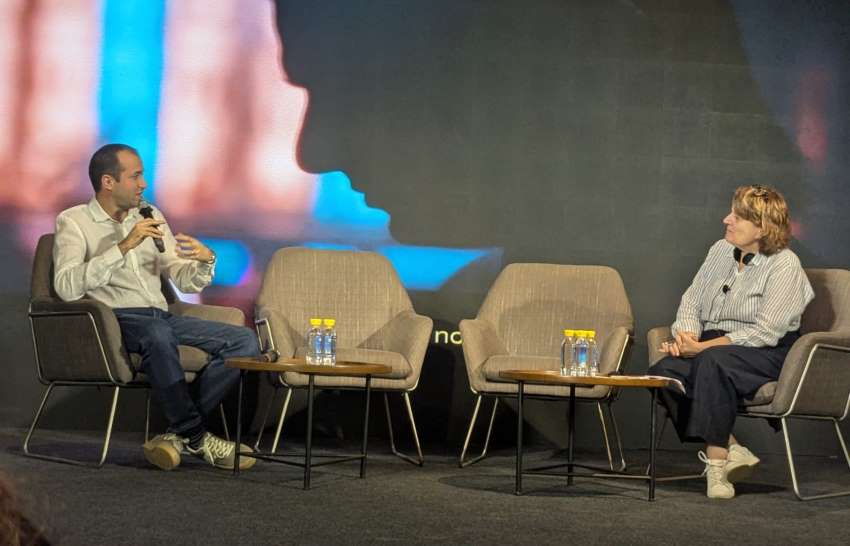FW
"India has a unique opportunity to reverse the decline in its export share and seize a global leadership position. Some of this opportunity is arising due to changing labour dynamics in China, which has been the world’s textiles behemoth. Indian the textile sector is one of the four most labour-intensive sectors of the economy, along with construction, agriculture and tourism sectors."

India has a unique opportunity to reverse the decline in its export share and seize a global leadership position. Some of this opportunity is arising due to changing labour dynamics in China, which has been the world’s textiles behemoth. Indian the textile sector is one of the four most labour-intensive sectors of the economy, along with construction, agriculture and tourism sectors. It has a huge potential for generating sustainable jobs as well as export earnings. Currently, it employs about 35 million people and contributes 12 per cent of exports. But just 15 years ago, the share of textiles and clothing in India’s manufacturing exports was more than 25 per cent.

India’s garment exports have now been overtaken in dollar terms even by its neighbour Bangladesh, and Vietnam may not be far behind. Of course, Bangladesh has benefitted from duty-free access to the European Union, and indeed some Indian entrepreneurs too have located themselves in that country for that reason. But Bangladesh’s transformation of its garment sector within a decade is nothing short of fantastic, offering some lessons for us as well.
Meanwhile, India has a unique opportunity to reverse the decline in its export share and seize a global leadership position. Some of this opportunity is arising due to changing labour dynamics in China, which has been the world’s textiles behemoth.
Textile a huge opportunity
Chief Economic Advisor (CEA) Arvind Subramanian has been championing the cause of this sector with compelling data. He points out most of the sustained East Asian growth of past decades was on the back of textile and clothing boom. Most tellingly, a unit of investment in the clothing sector generates 12 times as many jobs as the automobile sector and 30 times that of steel. Clearly, there is a big bang for the investment buck in textiles. Not surprisingly, the CEA’s passionate advocacy is showing results.
The recent reforms announced by the cabinet under a ‘textile package’ address some key impediments, and the package is timely. First, the reforms removed some of the embedded tax burden from exports through a duty drawback scheme. Secondly, firms are provided incentive to hire more workers through a subsidy to meet the EPF costs. But clearly much more needs to be done to harness the great promise. A CII-BCG study for textiles, made-ups and apparel estimates that the sector can generate 50 million jobs in the next nine years. Of these, more than 70 per cent will be for women. The study also shows that the shift of textiles and garments away from China is an annual opportunity of about 280 billion US dollars for other developing countries.
Advantage India
India has some advantages in being present in all parts of the value chain, beginning from fiber, yarn, fabric and going all the way to clothing, branded apparel and fashion. This is not to mention the new emerging markets like technical textiles that have industrial applications.
But here are two additional considerations that need close attention. First is the issue of fiber neutrality. In India, there is a curious frenemy relationship between cotton and man-made (synthetic) fibers. The global consumption pattern is 65:35 in favour of synthetics (like polyester, rayon, acrylic), whereas in India it is exactly the reverse. The net imports of the US and EU show a steady decline in cotton textiles vis-à-vis manmade fiber products over the past five years.
If India needs to tap into the export opportunity to these developed nations, our domestic mix has to mimic the global demand pattern. In India, cotton makes up 80 per cent of all fiber consumption whereas in China it is 50 per cent. This skew has been made worse due to the highly unequal excise tax treatment of cotton versus the rest. The textile ministry is aware of this asymmetry, and a fiber-neutral policy is on the anvil. Hopefully the GST regime will also discontinue the sharp asymmetry that has persisted for the past ten years.
FTAs, and their importance
Then there are the free trade agreements. Interestingly, the CEA himself is heading a committee to evaluate the costs and benefits of the several FTA that have been signed by India in the past couple of decades. Prima facie it appears that India’s trade deficit has uniformly gotten worse following several FTAs. No doubt, there has been trade enlargement, but not necessarily to India’s benefit. The reasons could be many – some fair, some unfair.
There is also the looming shadow of the mega treaty called the Trans Pacific Partnership which goes much beyond trade, and makes it compulsory for the entire value chain to be located in member countries. India is not a member of TPP and can potentially be at a serious disadvantage. Fortunately, the TPP is losing political support, so it may be several years into the future. Finally, despite these various hurdles, let us not lose sight of the huge promise of this sector (it is after all one of the trinity of roti, kapada, makaan), in generating large-scale jobs, especially for women, and healthy foreign exchange earnings. With proper policies and reforms, the textile sector in India is definitely heading for a high noon of great fortune.
No VAT will be imposed on dyes and chemicals used by processing units in Amritsar. These processing units were inspected and asked to deposit the tax. But they contended that dyes and chemicals used in the processing of clothes were not liable to tax. They say dyes and chemicals used in the process of washing, printing, coloring and dyeing of cloth are consumable and are, therefore, not liable to tax. The chemicals and dyes which are used are manufactured in other states. As of now the units have got temporary relief.
There are approximately 40 industrial houses in Amritsar which are engaged in the processing of grey cloth into finished fabric on job-work basis. The process involves coloring, printing, bleaching, washing and dyeing of grey cloth. The finished goods are the property of textile manufactures and returned to them on collection of job charges. There is no sale of fabric or cloth on the part of the processing units and the end product is tax-free in the state.
A final decision would be taken by the excise and taxation department whether the tax should be imposed. The dyes and chemicals are used in the process of job work undertaken by these units.
With the 2016 Autumn Edition of Intertextile Shanghai Apparel Fabrics to be held from October 11-13, the attention of global apparel fabrics and accessories industry has begun to focus on the same. Over 5,000 exhibitors from more than 25 countries and regions will take part and showcase their range of products across 260,000 sq. mt. of exhibition space at the Nation Exhibition and Convention Center (Shanghai). To ensure fair participants easily identify their target suppliers and buyers with so much on offer, a number of well-distinguished product zones are to be featured this year too.
In response to strong growth in the global active wear market, Intertextile Shanghai launched its first Functional Lab at the 2015 Autumn Edition. The zone has quickly garnered much attention in the industry with both exhibitors and buyers praising its effectiveness for capturing the opportunities in this high-potential market. Carrying on from the strong result of the debut edition, the Functional Lab (hall 5.2) is set to return this October.
As of this month, two pavilions, organised by INVISTA and Gyeongbuk Natural Color Industry Institute, as well as innovators from China, Hong Kong, Israel, Japan and Korea have already reserved their space to present a spectrum of the latest innovative products.
H&M’s sales including VAT increased by seven per cent in local currencies during the first six months of the financial year. Profits in the second quarter were negatively affected mostly by higher purchasing costs due to the strengthened US dollar and by increased markdowns.
H&M will offer e-commerce in 34 markets by the end of the year. The group plans a net addition of around 425 new stores for the 2015-2016 financial year. New markets for 2016 are Puerto Rico, New Zealand and Cyprus. Today the group has more than 4000 stores in strong retail locations in a total of 62 markets.
The combination of strong brands, a large body of retail stores in good locations and a successful e-commerce business puts H&M in a unique market position for future growth. H&M’s, continued focus is to grow both through physical stores and online as well as to integrate these two sales channels. H&M’s work on sustainability is an important part of its offering. For six years in a row H&M has been named by Ethisphere as one of the most ethical companies in the world. It has now climbed to 20th place in world’s most sustainable companies ranking. H&M is also included in the Dow Jones sustainability index of the most sustainable companies in Europe and the world.
This week, the cotton futures market in Australia propelled to an 18-month high with prices showing above 73 US cents per pound for October contracts. This has excited cotton growers in the country. Commodity advisor and cotton analyst Matthew Leeson, of Independent Commodity Management (ICM) observed that the price of cotton had been rising but several factors that happened this week caused the market to surge.
According to him, they were a little bearish on the price on a US basis following the June 30 planted acreage report in which they increased 600,000 acres above the expectation (which is around a million bales in round numbers). That was a little depressive for the market. But a number of fundamental and technical factors then changed the landscape and caused the increase in prices. He further added that the weather in Texas has changed with a forecast of warmer conditions. Now, they're looking for some rain.
Leeson goes on to say that then by the turn of the day, the US Department of Agriculture monthly supply and demand update played havoc with a few of the numbers specifically on the global scene where they actually boosted Chinese consumption for old and new crops by a million and a half bales. This has got this market rolling. However, he said that it was too soon to call the price increase, a trend. The Australian dollar, which has remained steady at around 75 cents US, has taken the edge of the futures market rally for the Australian cotton crop, all of which is exported. Currently, conditions are such that the mills have backed away, making the physical side of the market to diminish.
The global fashion industry has a massive impact on the environment. This impact extends from the pesticides used to grow fibers such as cotton to the impact textile dyes has on water in countries where regulations tend to go unenforced. Since 2011, Greenpeace, has been approaching leading brands to eliminate hazardous chemicals from their supply chains. And yes, it did achieve some results. Seventy-six leading fashion houses made a commitment to the organization that they would detoxify their operations by the end of this decade.
In its third annual “Detox Catwalk,” the organization has lauded the companies that are changing their working ways while rattling the cages of companies it believes are doing nothing. So what are the comments of Greenpeace on this?
Inditex, (which operates the popular Zara chain), Benetton and H&M are the three companies that have sold Greenpeace their believable timelines and have promised strong action and hasten the execution of their plans. All the three companies have won plaudits for moving to eliminate toxins such as PFCs in making progress on their long-term “zero discharge” plans. According to Greenpeace, these three companies, which earn almost $50 billion in combined revenues, have backed up their promises with transparency and concrete plans.
However, several leading brands are apparently doing nothing, and according to the environmental organization, have failed to take responsibility. Among these companies are Armani, Bestseller, Diesel, Hermes and Versace that earn the equivalent of what Greenpeace would call an “F” grade in describing their efforts.
Yarnex and Fabrics and Accessories (F&A) will be held in New Delhi, July 21 to 23, 2016. The twin shows have attracted 139 upstream supply chain partners across fibers, yarns, fabrics, trims, embellishments and services from all over India and overseas. They help buyers establish linkages with suppliers across the textile value chain.
Major exhibit categories include: natural, man-made and specialty fibers, natural, manmade fibers, fancy and various blended yarns and various fabrics made from natural and synthetic fibers. Accessories on show include buttons, hangers, interlinings, labels, laces, motifs, stones, studs, tapes, sewing and embroidery threads, zippers etc. The shows will also have service providers who offer services like textile related CAD/CAM, design institutes, logistics, textile testing and certification etc.
The twin shows are expected to be visited by international buying houses, agents, composite mills, weavers, knitters, garment exporters and manufacturers, apparel brands, retail chain stores etc. Yarnex is also a platform for display and dissemination of information on new product development and innovation. It is now firmly entrenched as a prominent brand and an important cog in the sourcing and business networking cycle for the textile value chain. It attracts leading Indian and international manufacturing companies who have successfully reached out to their target customers, setting up enduring business linkages.
Exports of Indonesian textile and textile products are only expected to grow one per cent in 2016, below the three per cent target. Even in the domestic market Indonesia has trouble competing with imports of cheap textile and textile products from Vietnam and China. Indonesian textile producers now control a domestic market share below 30 per cent.
The textile industry is one of the oldest industries in Indonesia and is one of the industries that is considered most badly affected by the country's economic slowdown after 2011. Indonesia's textile exports to Europe are subject to import duties in the range of 11 to 30 per cent, while Vietnam can export its textile products to the European Union with zero import duties. This makes Vietnam’s products much more competitive.
Recently, electricity tariffs were cut in an effort to support domestic industries. However, this incentive is yet to have a positive impact. It will require much more structural changes in order to boost the domestic textile industry and prevent more bankruptcies as well as mass layoffs.
The Indonesian textile industry also needs to seek non-traditional export markets in order to expand its export base. For example Turkey and Iran are countries that could be a new target.
India’s blended spun yarns exports were down 5.8 per cent year on year. During April 2016, blended spun yarn export value was up 11.2 per cent year on year while volumes rose 19.5 per cent as compared to the same month last year. India exported15.3 million kg of PC yarns during May. Polyester cotton yarns were exported to 47 countries in May 2016, of which Bangladesh and Honduras were the largest importers of PC yarn from India in May followed by Colombia.
Philippines, Australia, Russia, Venezuela and Guatemala were the fastest growing markets for PC yarns while the Dominican Republic significantly reduced its import of PC yarns from India. Algeria and Indonesia were among the 11 countries that did not import any PC yarns from India during May. Belgium was the major destination among the seven new markets found in May.
In May, PV yarns were exported to 31 countries from India. Turkey continued to be largest importer of PV yarns from India with a 52.5 per cent share of the total volume exported from India during the month. Russia and Yemen were the new major markets for PV yarn while six countries did not import any PV yarn during the month, including the major ones like Peru, Israel and Czech Republic.
As losses continue to mount, following the sharp rise in cotton prices, textile mills in Tamil Nadu (TN) that account for about 46 per cent of the total installed spinning capacity in the country, have reduced their production. According to officials, small and medium textile mills with a capacity of up to 25,000 spindles have reduced their production by about 15-20 per cent since the advent of the month.
Prices of Shankar-6, the most popular cotton variety used by mills in TN, have come up by 42% since April and has currently crossed 49,000 per candy (a candy is 355 kgs). Prices have jumped by about Rs 6,000 per candy in the last ten days alone. Interestingly, mills in the state have started importing cotton as prices are ruling lower in the international market. Since the cost of imported cotton is lower by at least Rs 2,000 per candy, many spinning mills, including smaller ones with a capacity of 10,000 spindles, are importing cotton now.












